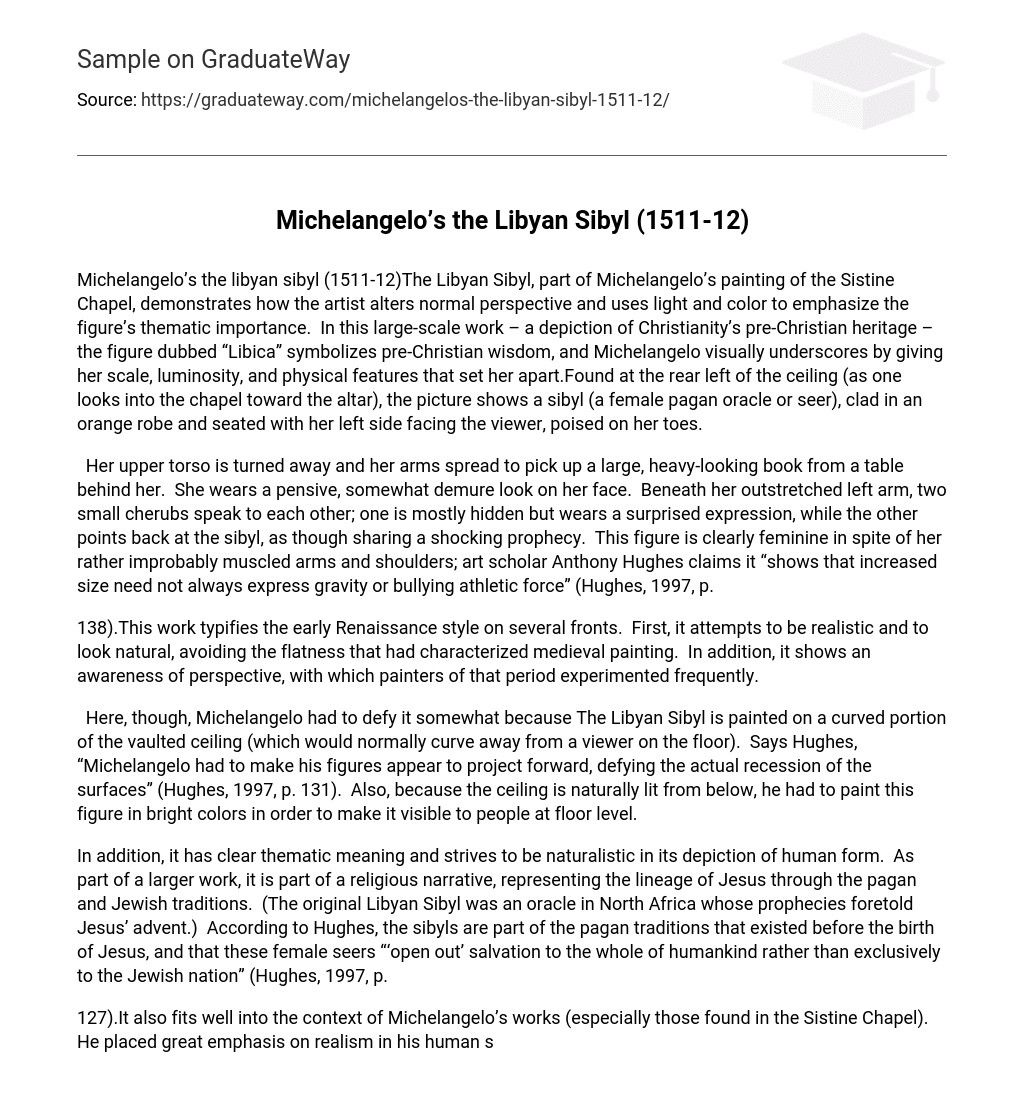Michelangelo’s the libyan sibyl (1511-12)The Libyan Sibyl, part of Michelangelo’s painting of the Sistine Chapel, demonstrates how the artist alters normal perspective and uses light and color to emphasize the figure’s thematic importance. In this large-scale work – a depiction of Christianity’s pre-Christian heritage – the figure dubbed “Libica” symbolizes pre-Christian wisdom, and Michelangelo visually underscores by giving her scale, luminosity, and physical features that set her apart.Found at the rear left of the ceiling (as one looks into the chapel toward the altar), the picture shows a sibyl (a female pagan oracle or seer), clad in an orange robe and seated with her left side facing the viewer, poised on her toes.
Her upper torso is turned away and her arms spread to pick up a large, heavy-looking book from a table behind her. She wears a pensive, somewhat demure look on her face. Beneath her outstretched left arm, two small cherubs speak to each other; one is mostly hidden but wears a surprised expression, while the other points back at the sibyl, as though sharing a shocking prophecy. This figure is clearly feminine in spite of her rather improbably muscled arms and shoulders; art scholar Anthony Hughes claims it “shows that increased size need not always express gravity or bullying athletic force” (Hughes, 1997, p.
138).This work typifies the early Renaissance style on several fronts. First, it attempts to be realistic and to look natural, avoiding the flatness that had characterized medieval painting. In addition, it shows an awareness of perspective, with which painters of that period experimented frequently.
Here, though, Michelangelo had to defy it somewhat because The Libyan Sibyl is painted on a curved portion of the vaulted ceiling (which would normally curve away from a viewer on the floor). Says Hughes, “Michelangelo had to make his figures appear to project forward, defying the actual recession of the surfaces” (Hughes, 1997, p. 131). Also, because the ceiling is naturally lit from below, he had to paint this figure in bright colors in order to make it visible to people at floor level.
In addition, it has clear thematic meaning and strives to be naturalistic in its depiction of human form. As part of a larger work, it is part of a religious narrative, representing the lineage of Jesus through the pagan and Jewish traditions. (The original Libyan Sibyl was an oracle in North Africa whose prophecies foretold Jesus’ advent.) According to Hughes, the sibyls are part of the pagan traditions that existed before the birth of Jesus, and that these female seers “‘open out’ salvation to the whole of humankind rather than exclusively to the Jewish nation” (Hughes, 1997, p.
127).It also fits well into the context of Michelangelo’s works (especially those found in the Sistine Chapel). He placed great emphasis on realism in his human sculptures and paintings, particularly on his depiction of physical movement. However, this one picture stands out from the other male and female prophets in the Sistine because it has an undeniable femininity combined with implied physical strength and wisdom.
Art scholar Charles Sala writes that the sibyl’s figure, like those of other women he depicted, “presents an anatomical complexity and a vivaciousness of body and gesture that stand in strong contrast” to the almost improbably strong-looking male figures and stern, unappealing females depicted elsewhere in the Sistine (Sala, 1996, p. 100).The Libyan Sibyl is typical of Renaissance painting for both its religious theme and its visual technique, which strives for three-dimensionality and realism. As a naturalistic depiction of human form, it is a good example of both the early Renaissance style and Michelangelo’s own work, which implied physical strength but also grace, and it fits into a larger thematic context of religious history and mythology.
WORKS CITEDAnonymous (2006). Sistine Chapel ceiling. Retrieved 18 April 2006 from http://en.wikipedia.
org/wiki/Sistine_Chapel_ceiling.Hughes, A. (1997). Michelangelo.
London: Phaidon.Sala, C. (1996). Michelangelo.
Paris: Terrail.





